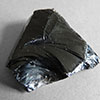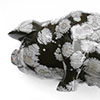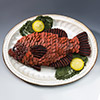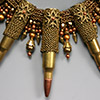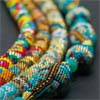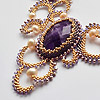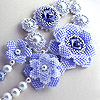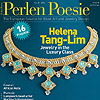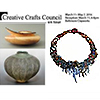February, 2016

From MyLovelyBeads.com with LoveAt last! It seems the winter is over and the spring is coming! Better late than never, read in the February issue of our MyLovelyBeads.com newsletter:
Obsidian - volcanic glass
Contact us with any questions at
info@mylovelybeads.com.
Fashion Colorworks 2016. Notes "Dangerous Goods" good for jewelry - R. Starry Beaders Best Bead Art Fair 2016 Inspired by country living - Elena Kononova Perlen Poesie Magazine. Issue 28 Upcoming events Best regards,
MyLovelyBeads.com Team |
Obsidian - volcanic glassObsidian is the rock formed when lava extruded from a volcano quickly cools without crystal growth. Thus, lava is the parent material and obsidian is a naturally occurring volcanic glass. Obsidian has been known since prehistoric times. The translation into English of Natural History written by Pliny the Elder shows a few sentences on the subject of a volcanic glass called Obsian, so named from its resemblance to a stone found in Ethiopia by Obsius, a Roman explorer. Obsidian is mineral-like, but not a true mineral because as a glass it is not crystalline; in addition, its composition is too complex to comprise a single mineral. It is sometimes classified as a mineraloid. Pure obsidian is usually dark in appearance, though the color varies depending on the presence of impurities; iron and magnesium typically give the obsidian a dark brown to black color. In some stones, the inclusion of small, white, radially clustered crystals of cristobalite in the black glass produce a blotchy or snowflake pattern, and this is known in the gem trade as snowflake obsidian. Obsidian has some fascinating properties as well as some important practical uses. It's hard and brittle; it therefore fractures with very sharp edges, which were used in the past in cutting and piercing tools, and it has been used experimentally as surgical scalpel blades. Well-crafted obsidian blades have a cutting edge many times sharper than high-quality steel surgical scalpels. The first known archaeological evidence of usage dated 700,000 BC were made in Kenya. The first attested civilized use is from excavations in Syria dated the late fifth millennia. Obsidian was valued in Stone Age cultures because of its cutting properties, it was also polished to create early mirrors. Obsidian was also used in ritual circumcisions because of its deftness and sharpness and for ornamental purposes and as a gemstone. Pre-Columbian Mesoamericans' use of obsidian was extensive and sophisticated; including carved and worked obsidian for tools and decorative objects. Mesoamericans also made a type of sword with obsidian blades mounted in a wooden body. Called "macuahuitl", the weapon was capable of inflicting terrible injuries, combining the sharp cutting edge of an obsidian blade with the ragged cut of a serrated weapon. Native American people traded obsidian throughout the Americas. Obsidian can be found in locations which have experienced volcano eruptions. It can be found in Argentina, Armenia, Azerbaijan, Australia, Canada, Chile, Georgia, Greece, Salvador, Guatemala, Iceland, Italy, Japan, Kenya, Mexico, New Zealand, Papua New Guinea, Peru, Scotland, Turkey and the United States. Obsidian flows which may be hiked on are found in the Cascade Range of western North America, and in the Sierra Nevada in California. Yellowstone National Park has a mountainside containing obsidian, and deposits can be found in many other western states in USA. |
|
Fashion Colorworks 2016. NotesVery soon, on April 1 we'll start getting Fashion Colorworks 2016 submissions! Many of you still work on your beauties, and some people email us and ask to explain the idea of using colors in the Fashion Colorworks contest. The rule says, "A participant has to create a piece with the predominant colors of one of the suggested triads (any shades of those colors)." It means that the colors of a triad MUST dominate in a contest piece. It's possible to use the shades of them to complement a design. It's also possible to use other colors if they don't distract one's attention (and of course, a juror's attention) from the main three colors. In general, more than three colors is pretty hard to implement, that's why we suggest only three and claim participants and jurors to focus on them. We wish you best of luck!
Fashion Colorworks 2016 rules
|
|
"Dangerous Goods" good for jewelryDo you like dangerous goods? We think your answer is going to be NO. Do you like unusual things? If you're a creative person, most likely you'll say, YES. Today we have an artist from the astonishing state of Alaska - Rebecca Starry, who can see an interesting in a dangerous and create unusual. Her non-traditional jewelry is eye-cathing and makes us wonder about human creativity. We hope you'll like Rebecca's story! 1. Rebecca, could you tell our readers about yourself and how you got started with beading and making jewelry? Years ago, a friend of mine and me would go to the local craft shows where we always admired the work of local bead artists. Then we began making and selling our own beaded jewelry in the 80's at the local bazaars. I had always admired the work of Virginia Blakelock and the detail she obtained in her loomed pieces. I too thought I would like to do loom work, but on a larger scale. I even had my husband help to make a large loom for such projects. However, I quickly became frustrated maintaining the tension on all of the warp threads and the thought of weaving in all of the threads after the loom work was completed seemed daunting. I thought I might be able to create the look of loom work with off loom stitches. I was attempting to teach myself square stitch when I developed a horizontal square stitch method. It's much like ndebele or herringbone, but with an extra thread path worked right to left that join the columns of beads and cause them to lay flat horizontally. I discovered I could create any shape or size by using this method and did not have to worry about tension or weaving in the threads when I finished. I was successful in creating the "Vivid Summer Vision" necklace which was juried into an exhibit at the Goldstein Gallery. Several other pieces were made using this method including "In Full Bloom" which has also been published and exhibited. Living through the long Alaskan winters was made a little brighter by creating colorful beadwork. I worked for many years in law enforcement and found beadwork provided a good balance to a stressful career. I also traveled to many rural Alaskan locations for my work and often took my beadwork with me. I found the local village women would open up and talk to me as they watched me bead. They would bring out their beadwork and we often traded jewelry. After taking David Chatt's class at the Coupeville Arts Center, I discovered the vast possibilities of beadwork using right angle weave. No stranger to larger pieces, I created "She has her beads to keep her warm" a scarf which incorporated both right angle weave and horizontal square stitch. I loved the way the beadwork warmed to the touch as you wore it.
Full interview with Rebecca Starry
|
|
Beaders Best Bead Art Fair 2016Bead Art Crossover: beginning 2016 year, BEADERS BEST Art Fair supported by Perlen Poesie magazine that has taken place for many years in Hamburg, Germany is joining "Mineralien, Fossilien, Schmuck" ("Minerals, Fossils, Jewelry") and "Kreativ" ("Creativity") shows at the Messe Stuttgart. A complete selection of components for all forms of jewelry making will be under one roof now! Exhibitors offer high quality glass beads, crystals, handmade beads, cabochons, gemstones, silk, jewelry wire, clasps and much more - all that a jewelry lover's heart could desire! Demonstrations and workshops are held at various booths. Jewelry projects and material kits are also available. As usual, the live jewelry fashion show and exhibition of jewelry designs will bring an air of sophistication to the fair. The event will take place from April 1 to 3, 2016.
Subscribe to Perlen Poesie magazine
|
|
Inspired by country livingBorn in a village in Siberia, Elena Kononova could know country living as it was, with all the difficulties and delights of rural life. One of its very important features is that people there make lots of things with their own hands. So, Elena's got a great chance to learn crafts from her family members. Later on, in many years, already living in a big city of Novosibirsk, she returned to what seemed to be forgotten for good - beadweaving. And her try made success! So, meet Elena Kononova! 1. Elena, have the members of your family ever crafted? What kind of crafts did they do? Crafting has always been a usual occupation. Perhaps more than a hobby - a necessity. I was born in a small village in Altai (Siberia), but grew up in a family of a military officer as a city girl. My parents have often moved from one father's duty station to another, so I sometimes had to live with my grandmother in the village for a long time, and I remember country life very well. In the house of my grandmother was a spinning wheel and she spun yarn; we wove rugs, quilted, knitted socks, embroidered tablecloths, napkins and clothes. Many things in our house were designed by ourselves, so to be able to do something with our own hands was commonplace for everyone, including me. I cannot imagine my life without crafts, even when watching TV, I'm always doing something. 2. What hobbies did you have in your childhood and youth? I have had a lot of passions: knitting, skating, drawing, choir singing, but I didn't have anything serious because with each new place of residence I had to discover something new that, on the other hand, was not so bad. 3. Tell us please how and when did you learn about beading? I made my first simple beaded bracelets when I was in high school. Then such jewelry was very popular, especially among young people, carried away rock music. "Baubles" have been woven with special meaning: each color and pattern meant something. I cannot say whether this was true, but a certain language of patterns have existed then. After that I completely forgot about beads. During this time I became a designer in the field of publishing and computer graphics, and later married. That's when I gave birth to my first daughter, I again turned to the beads. During my pregnancy, I started knitting children's clothes. Once searching on the Internet patterns I came across a knitted toy and was very fascinated by their creation. One day a relative of mine asked me to do a toy featuring a wedding couple, where the bride had to have a beautiful dress and veil, and here I discovered a long-forgotten box with beads. I made that toy and presented, but didn't close the box with beads! So beading came into my life and has been there to this day.
Full interview with Elena Kononova
|
|
Perlen Poesie Magazine. Issue 28PERLEN POESIE 28 is already live! Full of fresh jewelry ideas! 16 objects - from delicate and fluffy to "fit for a king" - invite you to brandish your needle and thread. Use netting, embroider full of volume or work in free beadweaving. This issue's course explains the African Helix technique. Helena Tang-Lim from Singapore designed the elegant Drina Victoria collar for you. All this and much more will spur your creativity on!
• Jewelry in the Luxury Class
Helena Tang-Lim: The jewelry designer's style is magnificent, with fine textures - it reflects the rich cultural mix of the Malay Archipelago, with Indian, Chinese, British and Arabic influences. Let yourself be inspired! • African Helix Enhance your knowledge: This time we are featuring a technique that we feel is too rarely used - especially when such a stunning structure can be so quickly achieved! • Machine-made Beauty Beauty from a machine: At the end of the 19th century, resourceful Saxons constructed "add-ons" to convert existing knitting machines to bead crochet machines. • Inventive Portrait of Martina Schlemminger: She would prefer to officially hold the title of "Glass Bead Maker", but this profession was deleted from the official register of qualified craftsmen in Germany over 60 years ago - read more about the artist from Schwabisch Hall in Germany.
Subscribe to Perlen Poesie magazine
|
|
Upcoming eventsCreative Crafts Council: On Tour
March 11 - May 21, 2016 The Baltimore Clayworks hosts Creative Crafts Council: On Tour. This exhibition features artists whose work had received awards at the Creative Crafts Council 30th Biennial Exhibition, which originally took place at Strathmore Mansion in June-July 2015. |
|
Note
If you don't see the newsletter properly formatted please click here:
February Issue
|
© 2016 MyLovelyBeads.com All Rights Reserved.
If you do not want receive our newsletter and you wish to remove your email address from our mailing list, please click the following link to unsubscribe.



